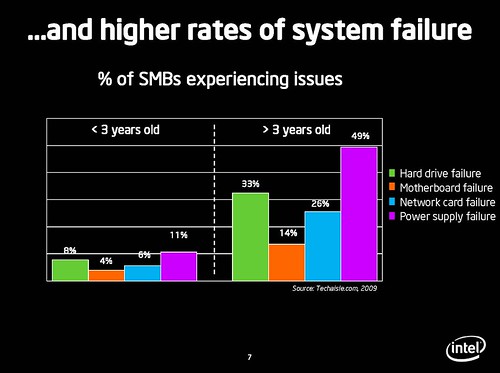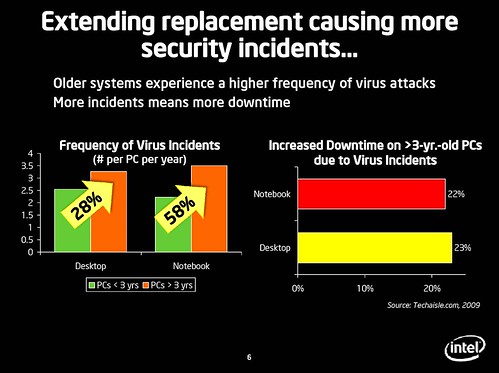When does buying new PCs for your business become cheaper than NOT buying new PCs for your business? According to Intel, it's when those PCs reach the ripe old age of... 3.

When does buying new PCs for your business become cheaper than NOT buying new PCs for your business? According to Intel, it's when those PCs reach the ripe old age of... 3.Inspired, no doubt, by the fact that the Great Recession is forcing many small and midsize businesses to extend their PC replacement cycles -- sometimes indefinitely -- Intel and research firm Techaisle are touting a new study that says older PCs can actually cost more to maintain than the cost of buying new ones.
Factoid: Projected 2009 Worldwide SMB IT Budget Growth: 4.6%
The study showed that 26% of small businesses and 43% of medsize businesses are keeping their PCs longer than they used to. But Robert Crooke, GM and VP in Intel's Business Client Group, acknowledged that the PC refresh strategies of small and midsize companies have always varied widely along with their IT sophistication. Some have regular refresh plans, he said, while many others replace PCs when they fail.
Not surprisingly, the study showed that older PCs also experience higher failure rates. But Crooke said that waiting for PCs to fail before replacing them can be very disruptive.

Dealing with a broken PC causes obvious problems, but the study showed that even when they were still working, PCs more than 3 years old suffered significantly more virus incidents and downtime. (Older machines are more vulnerable, Crooke said, because they often use outmoded software and may not be fully patched.)

Add it all up, and older PCs cost more than newer ones in several ways, varying slightly between small and midsize companies:
Maintenance: Small Biz: $326 Midsize: $401 Hardware updgrades: Small Biz: $99 Midsize: $98 Service costs: Small Biz: $120 Midsize: $210 Total: Small Biz: $545 Midsize: $709
For comparison, the first-year cost for a new PC is about $126.
And that doesn't include related costs such as user downtime, loss of data, and other business interruptions. Intel calculates that when you include those factors, payback on new machines can come in less than a year.
Sounds good, right?
Caveat Non-Emptor The study's central point that older PCs can get increasingly expensive to maintain, seems sound, but can we fully trust the specific numbers? For one thing, the study refers to PCs more than 3 years old, but doesn't say how old they are, or whether 3 years is a magic transition from new hotness to old and busted. Sure, 2-year-old PCs have more problems than brand new ones, and 7-year-old PCs no doubt have even more problems.
More to the point, the costs cited in the study are primarily soft costs, not necessarily cash outlays. Business owners are no dummies, and they know that ITE (in this economy) cash is king. That's why they're looking long and hard before buying new equipment no matter what the hidden costs of their current crop.
Finally, the idea that SMBs need to replace their PCs every three years even if they're still working well smacks of the planned obsolesence that long fueled the auto industry. Remember when you used to trade in your new Buick every three years? No one does that with cars anymore, and it's not necessarily realistic to ask them to do it with PCs.
Follow Fredric Paul on Twitter @ http://twitter.com/TheFreditor Follow bMighty.com on Twitter @ http://twitter.com/bMighty Put a bMighty gadget on your iGoogle page Get bMighty on your mobile device
About the Author(s)
You May Also Like





